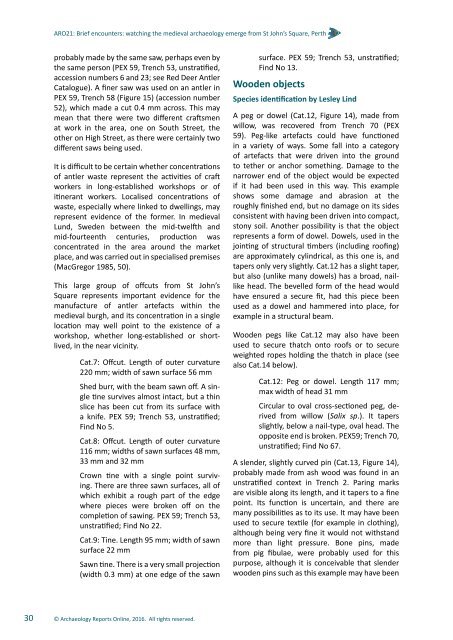medieval archaeology emerge from St John’s Square Perth
ARO21_St_Johns_Square
ARO21_St_Johns_Square
You also want an ePaper? Increase the reach of your titles
YUMPU automatically turns print PDFs into web optimized ePapers that Google loves.
ARO21: Brief encounters: watching the <strong>medieval</strong> <strong>archaeology</strong> <strong>emerge</strong> <strong>from</strong> <strong>St</strong> <strong>John’s</strong> <strong>Square</strong>, <strong>Perth</strong><br />
probably made by the same saw, perhaps even by<br />
the same person (PEX 59, Trench 53, unstratified,<br />
accession numbers 6 and 23; see Red Deer Antler<br />
Catalogue). A finer saw was used on an antler in<br />
PEX 59, Trench 58 (Figure 15) (accession number<br />
52), which made a cut 0.4 mm across. This may<br />
mean that there were two different craftsmen<br />
at work in the area, one on South <strong>St</strong>reet, the<br />
other on High <strong>St</strong>reet, as there were certainly two<br />
different saws being used.<br />
It is difficult to be certain whether concentrations<br />
of antler waste represent the activities of craft<br />
workers in long-established workshops or of<br />
itinerant workers. Localised concentrations of<br />
waste, especially where linked to dwellings, may<br />
represent evidence of the former. In <strong>medieval</strong><br />
Lund, Sweden between the mid-twelfth and<br />
mid-fourteenth centuries, production was<br />
concentrated in the area around the market<br />
place, and was carried out in specialised premises<br />
(MacGregor 1985, 50).<br />
This large group of offcuts <strong>from</strong> <strong>St</strong> <strong>John’s</strong><br />
<strong>Square</strong> represents important evidence for the<br />
manufacture of antler artefacts within the<br />
<strong>medieval</strong> burgh, and its concentration in a single<br />
location may well point to the existence of a<br />
workshop, whether long-established or shortlived,<br />
in the near vicinity.<br />
Cat.7: Offcut. Length of outer curvature<br />
220 mm; width of sawn surface 56 mm<br />
Shed burr, with the beam sawn off. A single<br />
tine survives almost intact, but a thin<br />
slice has been cut <strong>from</strong> its surface with<br />
a knife. PEX 59; Trench 53, unstratified;<br />
Find No 5.<br />
Cat.8: Offcut. Length of outer curvature<br />
116 mm; widths of sawn surfaces 48 mm,<br />
33 mm and 32 mm<br />
Crown tine with a single point surviving.<br />
There are three sawn surfaces, all of<br />
which exhibit a rough part of the edge<br />
where pieces were broken off on the<br />
completion of sawing. PEX 59; Trench 53,<br />
unstratified; Find No 22.<br />
Cat.9: Tine. Length 95 mm; width of sawn<br />
surface 22 mm<br />
Sawn tine. There is a very small projection<br />
(width 0.3 mm) at one edge of the sawn<br />
surface. PEX 59; Trench 53, unstratified;<br />
Find No 13.<br />
Wooden objects<br />
Species identification by Lesley Lind<br />
A peg or dowel (Cat.12, Figure 14), made <strong>from</strong><br />
willow, was recovered <strong>from</strong> Trench 70 (PEX<br />
59). Peg-like artefacts could have functioned<br />
in a variety of ways. Some fall into a category<br />
of artefacts that were driven into the ground<br />
to tether or anchor something. Damage to the<br />
narrower end of the object would be expected<br />
if it had been used in this way. This example<br />
shows some damage and abrasion at the<br />
roughly finished end, but no damage on its sides<br />
consistent with having been driven into compact,<br />
stony soil. Another possibility is that the object<br />
represents a form of dowel. Dowels, used in the<br />
jointing of structural timbers (including roofing)<br />
are approximately cylindrical, as this one is, and<br />
tapers only very slightly. Cat.12 has a slight taper,<br />
but also (unlike many dowels) has a broad, naillike<br />
head. The bevelled form of the head would<br />
have ensured a secure fit, had this piece been<br />
used as a dowel and hammered into place, for<br />
example in a structural beam.<br />
Wooden pegs like Cat.12 may also have been<br />
used to secure thatch onto roofs or to secure<br />
weighted ropes holding the thatch in place (see<br />
also Cat.14 below).<br />
Cat.12: Peg or dowel. Length 117 mm;<br />
max width of head 31 mm<br />
Circular to oval cross-sectioned peg, derived<br />
<strong>from</strong> willow (Salix sp.). It tapers<br />
slightly, below a nail-type, oval head. The<br />
opposite end is broken. PEX59; Trench 70,<br />
unstratified; Find No 67.<br />
A slender, slightly curved pin (Cat.13, Figure 14),<br />
probably made <strong>from</strong> ash wood was found in an<br />
unstratified context in Trench 2. Paring marks<br />
are visible along its length, and it tapers to a fine<br />
point. Its function is uncertain, and there are<br />
many possibilities as to its use. It may have been<br />
used to secure textile (for example in clothing),<br />
although being very fine it would not withstand<br />
more than light pressure. Bone pins, made<br />
<strong>from</strong> pig fibulae, were probably used for this<br />
purpose, although it is conceivable that slender<br />
wooden pins such as this example may have been<br />
30<br />
© Archaeology Reports Online, 2016. All rights reserved.


